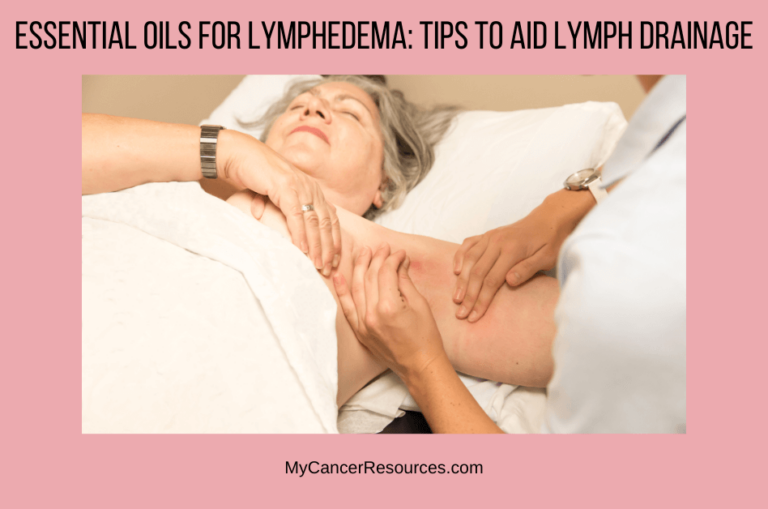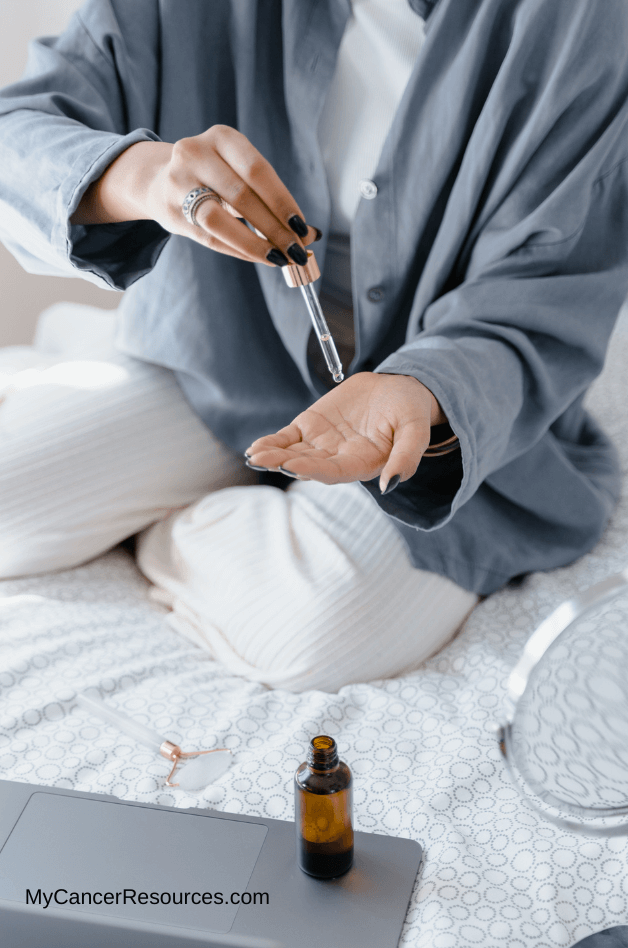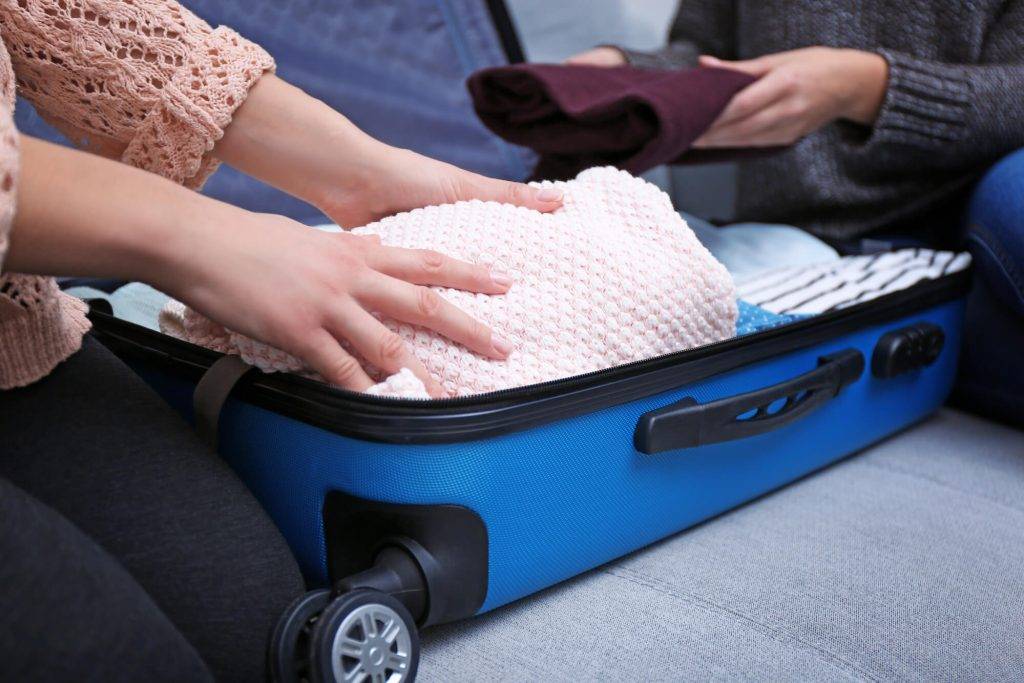My Cancer Resources is reader-supported. When you buy through links on the site, I may earn a small affiliate commission, at no cost to you. As an Amazon Associate, I earn from qualifying purchases.

A common side effect for people who have had lymph nodes removed or damaged by surgery or radiation, is lymphedema. This can be especially common in breast cancer patients. This condition ranges from uncomfortable to painful and debilitating. While lymphedema can’t be cured, he good news is that there are a number of ways to treat and relieve some of the swelling and discomfort. One of these ways is using essential oils for lymphedema drainage.
This article will review the lymph system and its purpose, what lymphedema is and ways to treat it using essential oils.
What is the Lymphatic System?
The lymphatic system is an important part of the immune system, which helps to fight off bacteria, viruses and cancer cells, to name a few. The job of the lymphatic system is to handle the housecleaning tasks of the body.
This system is responsible for creating lymph, a clear liquid and infusing it into the body’s tissues. Lymph acts like a vacuum cleaner, sucking up bacteria, viruses, toxins, etc. Lymph then travels through the system to lymph nodes, which are placed throughout your body, including the throat, armpits and groin.
Lymph nodes use white blood cells called lymphocytes to destroy these body invaders and waste products. Once destroyed, the used up lymphatic fluid and debris is collected by the circulatory system and flushed out of your body through your urinary tract.
What is Lymphedema?
Typically, there’s a good balance of lymph in our tissues. But when the lymph vessels get blocked or has trouble moving fluids, this causes a buildup of lymph, which leads to swelling.
This swelling is called lymphedema. It can range from minor swelling to having the tissues become overly swollen, red, hard, and painful to move.
Lymphedema isn’t just painful, it also prevents your immune system from working to protect you from infections and a build-up of toxins. For both of these reasons, it’s important to keep lymph moving through the body and treating lymphedema as quickly as possible when it develops.
The Role of Essential Oils in Lymphatic Health
Essential oils may not be the first thing you think of when you consider how to best support lymphatic health. But these natural essences of plants and herbs have been demonstrated to help with a number of medical conditions and side effects of cancer treatment, including restoring lymph movement.
Essential oils can safely be used in lymphatic massage, which is a type of massage specifically done to improve lymph flow. This can be done by a certified lymphatic massage therapist, or you can learn how to gently massage affected areas to improve circulation.
Essential oils can also be used in a post-dry brushing session to further boost the benefits of dry brushing. Using essential oils in body scrubs and applying to swollen areas may also provide some relief.
Let’s talk about which essential oils are best for lymphedema.
Top Essential Oils for Enhancing Lymphatic Drainage
- Citrus Oils: Including grapefruit, sweet orange and lemon, these oils are celebrated for their ability to enhance blood circulation and lymph flow. Their refreshing scent also helps uplift the spirits. Citrus oils also have diuretic properties, which can help the body get rid of lymphatic waste through the urinary tract system.
Note that if you use citrus oils, treated skin should not be exposed to sunlight within 12 hours of application. - Ginger: Known for its warming properties, ginger essential oil is excellent for stimulating lymphatic drainage and easing fluid retention. It’s a go-to for gentle massage, especially when addressing swelling related to lymphedema.
- Juniper Berry: A great detoxifier that improves both circulation and drainage of the lymphatic system.
- Geranium: A beautiful floral scent that not only helps in balancing emotions but its anti-inflammatory effect helps to reduce swelling. Geranium is often used to help relieve stress, anxiety and depression, all of which can be common for people with cancer.
- Bay Laurel: Often used in Traditional Chinese Medicine, bay laurel helps stimulate the body to make more lymphocytes. This is a great essential oil not just for lymphedema, but also for directly massaging onto lymph nodes when you’re starting to fight a cold, flu, or viral infection.
These essential oils can be used individually in a massage oil or you can select a few to create a custom essential oil blend.
Important Notes About Using Essential Oils for Lymphedema
It’s important that you do not apply essential oils directly on your skin. While there are a select few that are safe for direct topical applications like lavender, diluting essential oils into a carrier oil like jojoba oil or coconut oil is the way to go. This makes it easier to apply and massage into the skin, minimizes skin irritation and helps to maximize absorption of the essential oils.
Your massage therapist may already have their own essential oil blend created for lymphatic massage. If not, you may ask them if you can create one and bring it to your appointment.
To create your own blend, you’ll need the following items:
- 4 oz amber glass bottle with a dropper lid
- organic fractionated coconut oil
- essential oils – look for pure, organic, therapeutic grade essential oils. I personally love, use and recommend Melaleuca‘s oils. If you’re interested in purchasing their essential oils or other nontoxic cleaning agents, reach out to me. I’m happy to get you set up.
First, pour 3 oz of the coconut oil into the glass bottle. Then add a total of 40 drops of essential oil. Replace the dropper lid cap and gently swirl to mix.
*Note: If you’re creating a blend, you’ll use a TOTAL of 40 drops – not 40 drops of each oil in your blend. If you’re using just citrus essential oils, you may want to use a maximum of 30 drops, as the citrus family of essential oils can cause skin irritation.
Massage Cream
You might prefer cream over oil, especially if you wear wraps to compress an area like your arm or leg that’s prone to lymphedema. In that case, use 1-2 drops of your massage oil blend into 2 tablespoons of a non-greasy, unscented cream or lotion. This can absorb easier into your skin without leaving an oily residue.

How to Use Essential Oils for Lymphedema
Massage
The easiest method is to go to a massage therapist who has been trained in lymphatic drainage massage.
If that’s not an option, gentle manual lymph drainage can be done at home. Apply 5-10 drops of your homemade massage oil (the essential oil in a carrier oil blend mentioned above) into your hand and lightly massage the swollen area.
Apply very light, gentle movements in the direction of the heart. So if you have lymphedema in your arm, you or your caregiver will apply a small amount of oil and move in light upward strokes from your wrist up to your shoulder.
If you have a specific lymph node that is swollen, massage in a gentle, circular motion directly over it.
Post Dry Brushing
After completing a dry brushing session, you can gently massage your essential oil blend all over your body to further boost the dry brushing benefits. Follow the same tips as above, using light, gentle strokes that move in the direction of the heart.
Other Techniques to Help with Lymphedema
In addition to using essential oils via gentle massage and after dry brushing to improve your lymphatic system, make sure you’re well hydrated and are eating a nutritious, balanced diet. A diet high in antioxidants can help reduce water retention and the buildup of lymph.
Regular exercise can also help make sure your circulation is good and immune system is strong. Both of these systems are critical in helping move lymph and reducing swelling and pain caused by lymphedema.
If you have access to a certified lymphedema therapist, they may recommend specific exercises that can help promote lymphatic flow in the specific area of your body that are blocked. They may also recommend compression sleeves for you to wear to minimize swelling.
While these techniques can’t cure lymphedema, they can help improve the flow of lymph fluid, reducing swelling and pain, which can work wonders for improving your mobility and quality of life.



